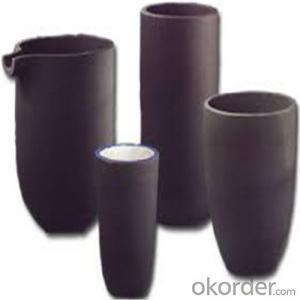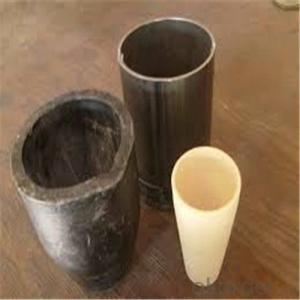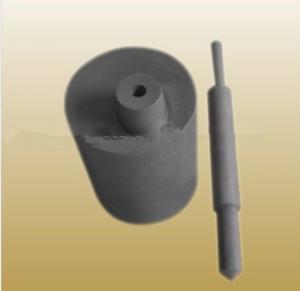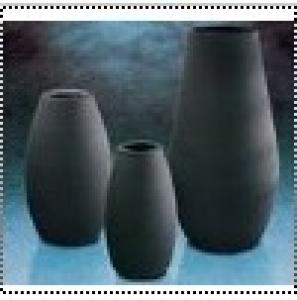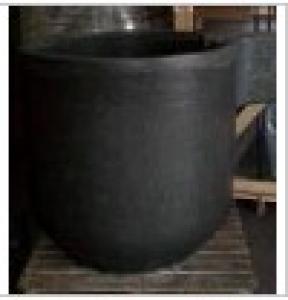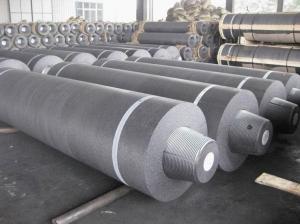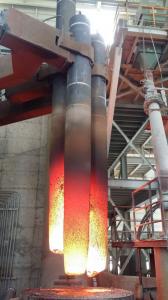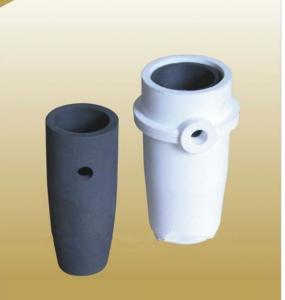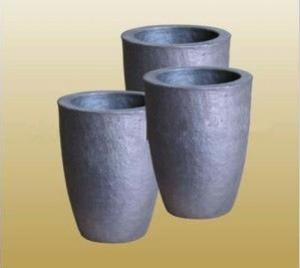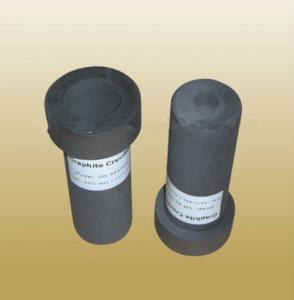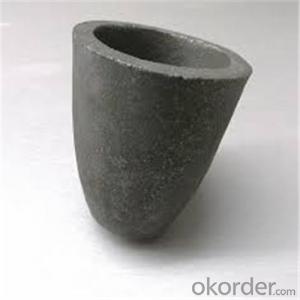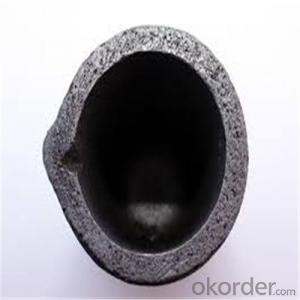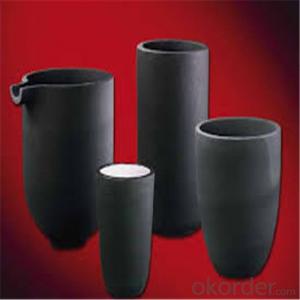SiC Crucibles For Melting Aluminium,Copper with High Heat Resistance
- Loading Port:
- Shanghai
- Payment Terms:
- TT OR LC
- Min Order Qty:
- 1 pc
- Supply Capability:
- 1000 pc/month
OKorder Service Pledge
OKorder Financial Service
You Might Also Like
Quick Details for SiC Crucibles For Melting Aluminium,Copper, Brass with High Heat Resistance
| Type: | High Strength, graphite crucible crucible | Application: | melting metal | Height: | as your requirements |
| Composition: | High Pure | Top Diameter: | 10-600mm | Bottom Diameter: | 10-1000mm |
| Place of Origin: | China (Mainland) | Brand Name: | Model Number: | ||
| Color: | Black grey | Si3N4%: | 5min | Fe2O3%: | 0.7max |
| C%: | 30-45 | Apparent porosity: | 30max | Refractoriness: | 1680 |
| Bulk Density: | 1.71min | Using life: | >5000 hours | MAX temperature: | 1600c |
Packaging & Delivery
| Packaging Details: | Seaworty packing or as per customer's detail requirement of graphite crucible. |
| Delivery Detail: | within 20-30 days after confirm order of graphite cru |
SiC Crucibles For Melting Aluminium,Copper, Brass with High Heat Resistance
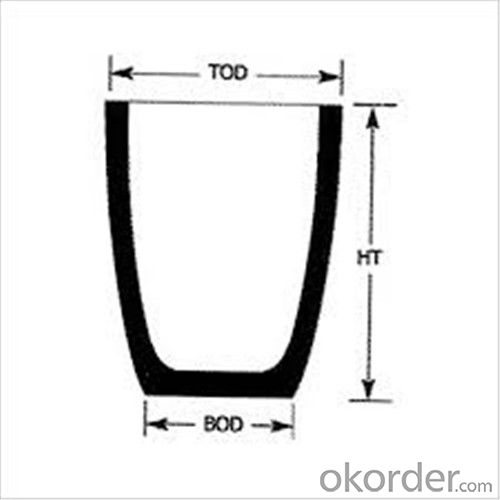

Features of SiC 95% silicon carbide sic crucible
1. resistance to deformation at high temperature,
2. thermal shock resistance, wear resistance, corrosion resistance.
3. anti-oxidation, anti- erosion.
Usage of SiC 95% silicon carbide sic crucible
electricity and steel slag trench,
coal chemical and mining transport pipeline.
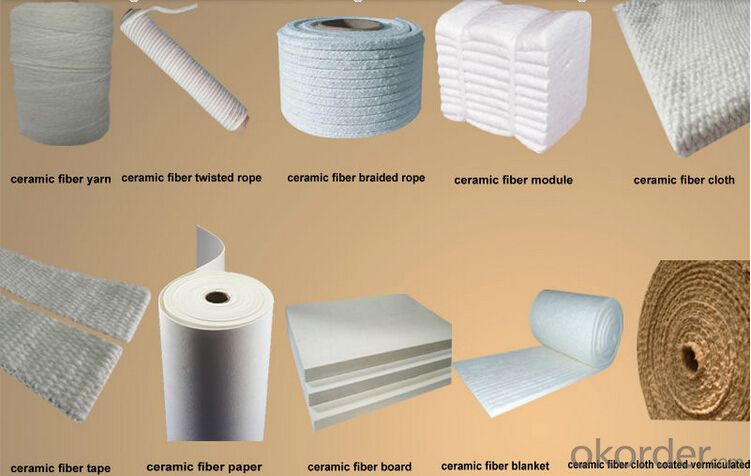
- Q:Is it possible to repair a cracked or damaged graphite crucible?
- No, it is not possible to repair a cracked or damaged graphite crucible. Graphite is a brittle material and once it is cracked or damaged, it cannot be repaired. It is recommended to replace the crucible to ensure proper functionality and safety.
- Q:Can graphite crucibles be used for melting composite materials?
- Yes, graphite crucibles can be used for melting composite materials. Graphite crucibles have excellent thermal conductivity and high melting point, making them suitable for melting a wide range of materials including composites. However, it is important to consider the specific requirements of the composite material being melted to ensure compatibility and avoid any potential reactions or contamination.
- Q:How do you prevent contamination of the melted material in a graphite crucible?
- To prevent contamination of the melted material in a graphite crucible, there are several precautions that can be taken: 1. Proper cleaning and preparation of the graphite crucible before use is essential. Any residual material from previous uses should be thoroughly removed. This can be done by scrubbing the crucible with a brush and using a suitable cleaning agent. 2. It is important to handle the crucible with clean gloves to avoid transferring any contaminants from your hands onto the crucible surface. 3. When loading the material into the crucible, it is crucial to ensure that the material is clean and free from any impurities. Any foreign particles or contaminants should be removed before loading. 4. The crucible should be placed in a clean and controlled environment to minimize the chances of contamination. Avoid placing the crucible on dirty or contaminated surfaces that could impact the integrity of the melted material. 5. Care should be taken while transferring the crucible into the melting apparatus to avoid contact with any contaminants. Using clean tools and equipment is important in this process. 6. Heating the crucible slowly and gradually can help prevent contamination. Rapid temperature changes can cause impurities or residues to vaporize and contaminate the melted material. 7. It is recommended to use a lid or cover on the crucible during the melting process. This helps to prevent any airborne contaminants from entering the crucible and contaminating the melted material. 8. Regular inspection and maintenance of the crucible are necessary to identify any signs of contamination. If any contamination is noticed, the crucible should be cleaned thoroughly before further use. By following these preventive measures, the risk of contamination in a graphite crucible can be significantly reduced, ensuring the purity and integrity of the melted material.
- Q:What kind of equipment is needed to refine the battery lead?
- Investment is a little big, I wonder if I can afford it. Followed by dry pot with gasoline, again dry wok with coke, followed by dry pot plus high-quality anthracite, the most economical!!! The melting of the rotor aluminum in the motor plant is done with this.
- Q:Can graphite crucibles be used for electron beam melting processes?
- Graphite crucibles are indeed capable of being used in electron beam melting processes. They possess exceptional thermal conductivity, a high melting point, and commendable resistance to chemical attack, rendering them appropriate for high-temperature applications like electron beam melting. The remarkable thermal conductivity of graphite aids in the effective transfer of heat, thereby enabling uniform heating and melting of the material. Moreover, graphite crucibles exhibit excellent dimensional stability, a vital factor in ensuring precise control over the melting process. Consequently, graphite crucibles are widely favored in electron beam melting processes due to their advantageous attributes.
- Q:How do you prevent graphite crucibles from thermal expansion-related issues?
- There are several measures that can be taken to prevent issues related to thermal expansion in graphite crucibles: 1. Gradual preheating is essential before using a graphite crucible. This process eliminates any residual moisture and volatile substances in the crucible, while also allowing uniform expansion and reducing the risk of thermal shock. 2. Careful cooling is crucial after use. Sudden temperature changes can cause thermal stress and result in cracking or fracturing. Allowing the crucible to cool gradually ensures controlled thermal expansion and minimizes the risk of damage. 3. It is important to avoid subjecting the crucible to extreme temperatures. Each graphite crucible has a specific temperature range within which it can safely operate. Following the manufacturer's guidelines and not exposing the crucible to extreme temperatures is essential to prevent thermal expansion-related issues. 4. Proper handling and storage are necessary to avoid damage to the crucible. Dropping or impacting the crucible can weaken its structure and make it more susceptible to thermal expansion issues. Additionally, storing the crucibles in a cool and dry environment prevents moisture absorption, which can affect their thermal stability. 5. Regular inspection is important to identify any signs of wear, cracks, or other damage in the graphite crucibles. It is crucial to replace any crucibles that show degradation to prevent potential thermal expansion-related issues during use. By following these preventive measures, the risk of thermal expansion-related issues in graphite crucibles can be significantly reduced, ensuring their longevity and optimal performance.
- Q:Graphite and diamond are elemental elements made of carbon. Why are physical properties so different?
- Similarities and differences between diamond and graphite:graphiteGraphite and diamond are pure carbon, chemical formula of the two is C, a covalent bond, the molecular structure of graphite, their chemical properties are basically the same. But the diamond and graphite are not homogeneous material, they are allotropic body is composed of the same elements of carbon. Mainly because of their spatial structure is different, each atom between the graphite elemental form a planar structure, hexagonal flaky, a molecular bond between layer and layer, layer between sliding easily, so graphite is soft, dark gray, metallic luster, touch a greasy feeling and have a dark grey traces. Because the hexagonal structure is stable, so high temperature graphite, graphite can do high temperature lubricant. Therefore graphite has properties of high temperature resistance, good electrical conductivity, thermal conductivity, lubrication, plasticity and chemical stability.
- Q:Is it possible to cast or mold materials using a graphite crucible?
- Yes, it is possible to cast or mold materials using a graphite crucible. Graphite crucibles are widely used in various industries, including foundries, jewelry making, and metal casting. Graphite has high thermal conductivity and can withstand high temperatures, making it an ideal material for melting and casting processes. It is commonly used for melting metals, alloys, and other materials that require high heat resistance. The graphite crucible provides a controlled environment for the molten material, ensuring efficient and precise casting or molding.
- Q:Can graphite crucibles be used for carbon fiber production?
- Carbon fiber production can utilize graphite crucibles, which are often employed in high-temperature situations due to their exceptional thermal conductivity, high melting point, and chemical resistance. To create carbon fiber, graphite crucibles can be utilized to heat and liquefy the precursor materials like polyacrylonitrile (PAN) or pitch. These materials then undergo a series of steps to generate carbon fiber. Graphite, known for its high-temperature stability and lack of reactivity, serves as an ideal substance for maintaining the necessary conditions during the carbonization process. Furthermore, the smooth surface of graphite crucibles plays a significant role in achieving uniform heat distribution, an essential factor in ensuring the quality and consistency of carbon fiber production. As a result, graphite crucibles prove to be a suitable choice for the production of carbon fiber.
- Q:Can graphite crucibles be used for material synthesis?
- Material synthesis can utilize graphite crucibles, as they possess distinctive properties that make them an excellent choice. Graphite's high melting point, exceptional thermal conductivity, and chemical inertness render it appropriate for various high-temperature reactions and processes. Graphite crucibles find frequent use in synthesizing metals, alloys, ceramics, and compounds. They are particularly favored for tasks involving high temperatures, such as melting, heating, and vaporization. Graphite's high thermal conductivity enables efficient heat transfer, ensuring uniform heating and temperature distribution throughout the crucible. Chemical inertness is another advantage of graphite crucibles. They do not react with most materials, making them ideal for synthesizing compounds or alloys without contamination. Additionally, graphite exhibits low reactivity with oxygen, which is crucial in preventing unwanted oxidation during material synthesis. Graphite crucibles are also renowned for their durability and resistance to thermal shock. They can withstand rapid temperature changes without cracking or breaking, ensuring the integrity of the material synthesis process. This durability allows for repeated use of the crucibles, making them a cost-effective option in the long run. In conclusion, the widespread use of graphite crucibles in material synthesis can be attributed to their high melting point, excellent thermal conductivity, chemical inertness, and durability. These unique properties make them suitable for a wide range of applications and ensure the successful synthesis of various materials.
1. Manufacturer Overview |
|
|---|---|
| Location | |
| Year Established | |
| Annual Output Value | |
| Main Markets | |
| Company Certifications | |
2. Manufacturer Certificates |
|
|---|---|
| a) Certification Name | |
| Range | |
| Reference | |
| Validity Period | |
3. Manufacturer Capability |
|
|---|---|
| a)Trade Capacity | |
| Nearest Port | |
| Export Percentage | |
| No.of Employees in Trade Department | |
| Language Spoken: | |
| b)Factory Information | |
| Factory Size: | |
| No. of Production Lines | |
| Contract Manufacturing | |
| Product Price Range | |
Send your message to us
SiC Crucibles For Melting Aluminium,Copper with High Heat Resistance
- Loading Port:
- Shanghai
- Payment Terms:
- TT OR LC
- Min Order Qty:
- 1 pc
- Supply Capability:
- 1000 pc/month
OKorder Service Pledge
OKorder Financial Service
Similar products
New products
Hot products
Related keywords

